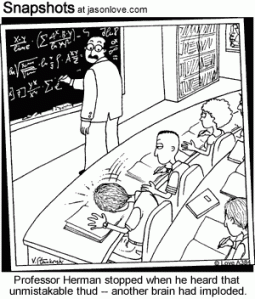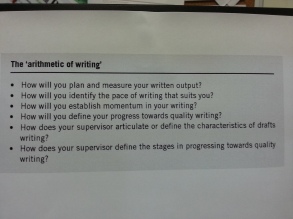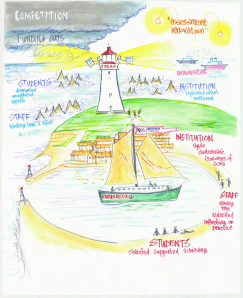I came on a writing retreat this week as I hoped it would allow me time and space to take stock of the Development Project so far and support reflection. The Mirfield Centre is a beautiful place (http://www.mirfieldcentre.org.uk/) and the people are very welcoming. Just wish I’d been able to attend all week instead of just 2 days. Thank you to Janet Ho and Sharon Prentis for arranging such an excellent course in such an inspiring venue.
The first hour of ‘free writing’ stimulated more questions than provided answers. Not a problem as they ” However, I first need to get a few things off my chest.
The Development Project continued
This is an appropriate time to reflect given I’ve finished adding feedback to the students’ methodologies online. As usual there have been barriers to reflection as well as to actually getting time to add feedback. This last issue may be resolved within my normal practice in the future as I’ve been marking work formatively online in addition to my usual workload. I did try to set aside a week for this at the end of last term, but this was too early for most students and they mainly submitted work at the end of January through to March.As this is also the busiest term for me, the marking got done mainly within the last month and blog posts also got postponed until now :-).
Selling Off the Family Jewels

Another issue that has also intruded has been the transfer of the campus where I work to a local FE college and this has greatly affected everyone who works at the campus (staff at the main site have been sympathetic, but it’s like divorce, until you’ve experienced it, it’s hard to understand some of the pain – yes pain – that we have felt and continue to feel. Contrary to the information supplied by ACAS about keeping people informed, the decision was taken to ‘sell off the family jewels’ and ask the local FE college to take over the campus and HE provision. The first we heard about it was at a meeting with the VC and by then we were already in the TUPE process.
The shock is still felt several months later and although we are now past the denial and anger staes (Kübler-Ross model, Curious Tendency, 2003); see below::
we are still feeling rejected (depression stage; not sure if we’ve reached the acceptance stage, perhaps some of us have, but I’m not sure I’m there as yet) and in limbo as the final ‘signing over’ does not take place until August and questions we ask (bargaining ?) are unable to be answered. Whilst this issue isn’t a part of my MSc development project, it does explain why at times, it feels pointless carrying on with it. However, I am still interested in the aim of the project and want to understand how effective delivering feedback online can be. I will also still be working as an Academic Skills Tutor if I decide to ‘go with the flow’ and transfer, or whether I apply for positions elsewhere, so for this reason, I will continue with the researh: intrinsic rather than extrinsic motivation (Ryan, 2000).
Can you have too many questions ?
There are many questions that have arisen in researching this project and these have crystallized at the Retreat when I’ve had time and space to reflect-on-action (Schön, 1991); questions such as:
- Most of the feedback I am giving seems to do with correcting mistakes in punctuation – should I have been proofreading ?
Spelling and grammar haven’t been a major problem except here and there, but punctuation has, particularly with regard to correct use of semi-colons – I thought of adding this to the quickmarks set I was using, but for some reason I wasn’t able to do this (my grasp on the technology perhaps, or lack of it).
In hindsight, it would have saved time if I had customized the quickmarks with a link to a website or video to show how to use semi-colons correctly, along with colons and commas as people were mixing up all three in the methodologies I was marking.
Is punctuation a big issue ? Lynne Truss (“Eats, Shoots and Leaves”) thinks so: “Proper punctuation is both the sign and the cause of clear thinking” Truss (2003). So if we want our students to show evidence of this in their writing, they need to understand how to punctuate properly. I also consider that semi-colons ‘lift’ one’s writing – make it more sophisticated, academic even (like signposting) – why ? I’m even thinking of writing a paper entitled: Semi-colons and Signposting; the role of bit players in the drama of academic argument”.
- Poor referencing even in Year 3 – ‘it ain’t hard’, so why do students get it wrong ? An inability or reluctance to follow rules?
- The process of adding assessing and adding feedback online has been time consuming – should I have spent time setting up a quickmarks set to suit what I wanted to focus on (see above)? To do this I should have conducted a pilot study with a number of students to try to ascertain what the common errors might be. However, as Sadler (1989) argues, every student is different and every subject may require different feedback so this strategy might not have worked.
- I did not use a rubric – why not ? This should have been addressed, as I had already uncovered evidence to support a shared understanding of learning outcomes for effective feedback in the research (Black and William, 1998; Sadler, 1989; Juwah et al, 2004). Relating learning outcomes to the appropriate rubric could have been discussed with the students in the first term and we could have shared knowledge and used examples to increase understanding of what we as tutors wanted and what students were required to do in relation to the Learning Outcomes.
- The lack of interpersonal communication, visual clues and the inability to follow up questions has been another issue; the online environment can create barriers to communication (Vonderwell, 2006). Not sure whether this made the process more time consuming as I needed to add extra detail to get my point across or took less time because I wasn’t engaged in conversation.
- Intext feedback and General Comment / audio comment – how were these used ?
These were some of the questions that occurred to me during my first formal reflection at the Mirfield Retreat and forms the first s of two related blog posts; the second post considers ‘the larger questions’.
Post script
Another question that a colleague raised when we discussed our day and what we felt we had achieved is a really important one that I had somehow overlooked or hadn’t really targeted in the first stage of the research: “how do we know when our feedback has been effective ?”. This of course is discussed in ‘closing the gap’ (Juwah et al, 2004) and elsewhere (Sadler, 1989, Black and William, 1998) but it also seems like a truism to state – we think the feedback has been effective when students get better marks, but how do we really know ? How can we be sure that it is our feedback that is causing our students to improve ? This is really key to my whole project and practice and at the heart of what teachers believe and do: that teaching has a positive effect on achievement (and lots of other areas – self fulfilment, developing the whole person etc etc). The question remains: how do we measure achievement and so we revert to bevahiourist learning approaches (Ertmer, and Newby, 1993).

References
Black, P. and William, D. (1998) ‘Assessment and Classroom Learning’, Assessment in Education: Principles, Policy and Practice, Vol 5 (1), March, pp7-71.
Curious Tendency (2012) Elisabeth Kübler-Ross – 5 Stages Of Grief Model 18 February, 2012. Curious Tendency: Blog [online]. Available at: http://curioustendency.blogspot.co.uk/2012/02/elisabeth-kubler-ross-5-stages-of-grief.html#.UUwwLFKDjms [Accessed 22nd March 2013].
Ertmer, P. and Newby, T. (1993) ‘Behaviourism, Cognitivism, Constructivism: Comparing critical features form an instructional design perspective’. Performance
Improvement Quarterly. 6 (4) pp50-72. Available at: http://uow.ico5.janison.com/ed/subjects/edgi911w/readings/ertmerp1.pdf
[Accessed 9th December 2011].
Juwah, C., Macfarlane-Dick, D., Matthew, B., Nichol, D., Ross, D. and Smith, B. (2004) ‘Enhancing student learning through effective formative feedback’,
The Higher Education Academy [online]. Available at: http://www.heacademy.ac.uk/assets/documents/resources/database/id353_senlef_guide.pdf [Accessed 2nd September 2012].
Sadler, R. 1989) ‘Formative Assessment and the Design of Instructional Systems’, Instructional Science, Vol 18, pp119-144 [online]. Available at: http://michiganassessmentconsortium.org/sites/default/files/MAC-Resources-FormativeAssessmentDesignSystems.pdf [Accessed 18th November 2012].
Vonderwell, S. (2003) An examination of asynchronous communciation experiences and perspectives of students in an online course: a case study, The internet and Higher Education, Vol 6, first quasrter, pp.77-90 [online]. Avbailable at: http://www.sciencedirect.com.libaccess.hud.ac.uk/science/article/pii/S1096751602001641 [Accessed 22nd March 2013].





